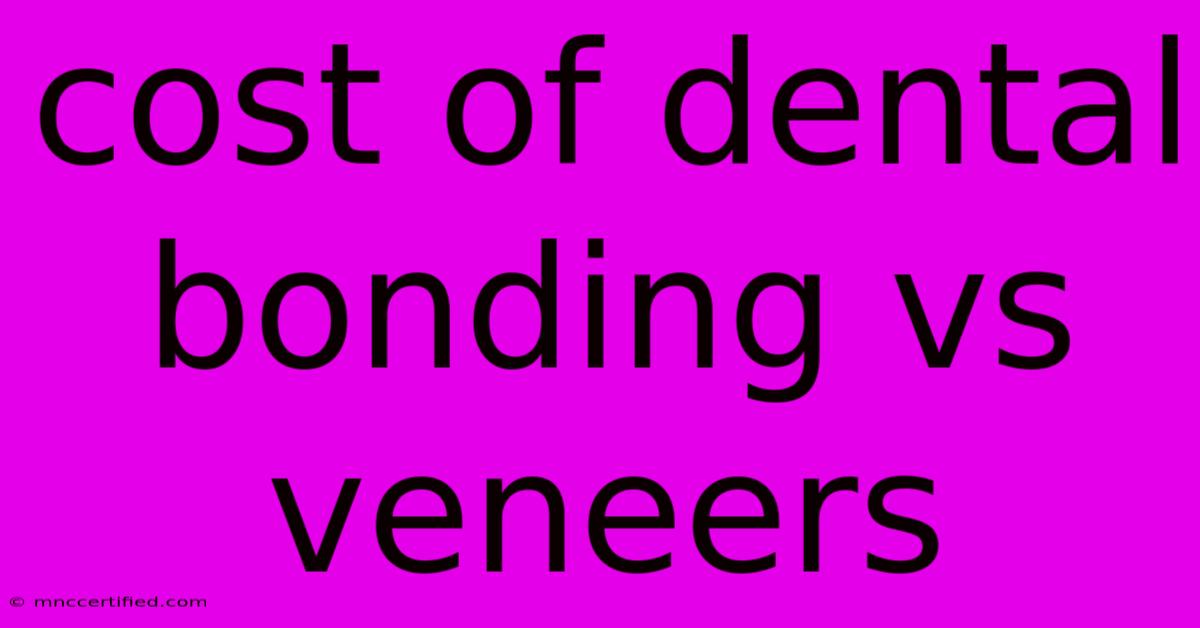Cost Of Dental Bonding Vs Veneers

Table of Contents
Cost of Dental Bonding vs. Veneers: A Comprehensive Guide
Choosing between dental bonding and veneers can significantly impact your budget and smile. Both procedures improve the appearance of your teeth, but they differ dramatically in cost, longevity, and the extent of tooth preparation required. This comprehensive guide will break down the cost differences, helping you make an informed decision.
Understanding the Procedures
Before diving into the pricing, let's clarify what each procedure entails:
Dental Bonding
Dental bonding involves applying a tooth-colored resin to your teeth. This resin is sculpted and hardened with a special light to repair chips, close gaps, or improve the overall appearance of your teeth. It's a less invasive procedure, often requiring minimal to no tooth preparation.
Porcelain Veneers
Porcelain veneers are thin, custom-made shells that are bonded to the front surface of your teeth. They are made from porcelain, a durable material that resists staining and mimics the natural appearance of teeth. Veneers require more extensive tooth preparation, usually involving the removal of a small amount of enamel.
Cost Comparison: Bonding vs. Veneers
The cost difference between bonding and veneers is substantial. Several factors influence the final price, including:
- Geographic Location: Costs vary widely depending on your location. Dental practices in major cities tend to charge more than those in smaller towns.
- Dentist's Experience: Experienced cosmetic dentists often charge higher fees.
- Number of Teeth Treated: The more teeth needing treatment, the higher the total cost.
- Material Quality: Higher-quality materials, like premium porcelain for veneers, will increase the overall expense.
General Cost Estimates (per tooth):
- Dental Bonding: $300 - $600
- Porcelain Veneers: $800 - $2,000+
Important Note: These are estimates. It's crucial to consult with your dentist for an accurate quote based on your specific needs and their pricing structure.
Breaking Down the Cost Differences
The significant price difference stems from several factors:
- Material Costs: Porcelain is a more expensive material than composite resin used in bonding.
- Procedure Complexity: Veneers require more intricate laboratory work and a more involved chairside procedure.
- Longevity: Veneers typically last longer than bonding, justifying the higher upfront cost for some patients.
Longevity and Maintenance
While both procedures can improve your smile, their longevity differs:
- Dental Bonding: Can last 3-10 years, depending on care and location. It's more prone to chipping and staining than veneers.
- Porcelain Veneers: Can last 10-15 years or even longer with proper care. They are more resistant to staining and chipping.
Choosing the Right Option for You
The best option depends on your individual needs, budget, and expectations.
-
Choose bonding if: You have a smaller budget, need minor cosmetic improvements, and are comfortable with a shorter lifespan. Bonding is ideal for repairing small chips, closing minor gaps, or improving the color of a single tooth.
-
Choose veneers if: You're seeking a long-lasting, more dramatic smile transformation and are willing to invest more money. Veneers are excellent for addressing significant discoloration, severely chipped teeth, or uneven spacing.
Consult your dentist! A thorough consultation will help determine which procedure best suits your oral health and aesthetic goals. They can provide personalized cost estimates and discuss long-term care and maintenance for either treatment.
SEO Optimization Considerations
This article incorporates several SEO strategies:
- Keyword Targeting: Uses relevant keywords like "dental bonding cost," "veneers cost," "bonding vs veneers price," "cost of dental veneers," etc., naturally throughout the text.
- Header Structure: Employs H2 and H3 headers for improved readability and SEO.
- Bold Text: Highlights key information for better readability and emphasis.
- Long-Form Content: Provides comprehensive information to satisfy user search intent.
- Internal Linking (Not Included Here but Recommended): Link to other relevant articles on your website (e.g., articles on dental hygiene, other cosmetic procedures).
- External Linking (Not Included Here but Recommended): Link to reputable sources for further information (e.g., ADA website).
By following these SEO best practices and providing valuable, informative content, this article aims to rank highly in search engine results pages (SERPs) for relevant keywords. Remember to adapt and expand upon this content based on your specific target audience and website.

Thank you for visiting our website wich cover about Cost Of Dental Bonding Vs Veneers. We hope the information provided has been useful to you. Feel free to contact us if you have any questions or need further assistance. See you next time and dont miss to bookmark.
Featured Posts
-
Final Betting Odds Lsu Florida Game
Nov 17, 2024
-
Conquer The Interview A Practical Guide
Nov 17, 2024
-
Charlize Theron Sees Paul Vs Tyson
Nov 17, 2024
-
East 17 Now Members Songs Breakup
Nov 17, 2024
-
Texas Vs Arkansas Live Game Score
Nov 17, 2024